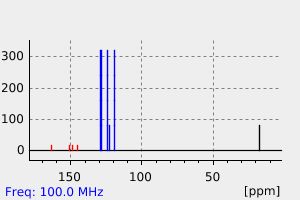[1-(4-Nitro-phenyl)-eth-(E)-ylidene]-phenyl-amine | 76154-07-9
中文名称
——
中文别名
——
英文名称
[1-(4-Nitro-phenyl)-eth-(E)-ylidene]-phenyl-amine
英文别名
(E)-1-(4-nitrophenyl)-N-phenylethan-1-imine
CAS
76154-07-9
化学式
C14H12N2O2
mdl
——
分子量
240.261
InChiKey
KAFLIVPUBWCPSR-RVDMUPIBSA-N
BEILSTEIN
——
EINECS
——
-
物化性质
-
计算性质
-
ADMET
-
安全信息
-
SDS
-
制备方法与用途
-
上下游信息
-
文献信息
-
表征谱图
-
同类化合物
-
相关功能分类
-
相关结构分类
计算性质
-
辛醇/水分配系数(LogP):3.74
-
重原子数:18.0
-
可旋转键数:3.0
-
环数:2.0
-
sp3杂化的碳原子比例:0.07
-
拓扑面积:55.5
-
氢给体数:0.0
-
氢受体数:3.0
反应信息
-
作为反应物:描述:[1-(4-Nitro-phenyl)-eth-(E)-ylidene]-phenyl-amine 在 三氟化硼乙醚 、 间氯过氧苯甲酸 作用下, 以 氯仿 为溶剂, 反应 1.0h, 以78%的产率得到N-acetyl-4-nitrodiphenylamine参考文献:名称:Kim, So Yeon; An, Gwang-Il; Rhee, Hakjune, Synlett, 2003, # 1, p. 112 - 114摘要:DOI:
-
作为产物:描述:苯胺 、 对硝基苯乙酮 在 4 A molecular sieve 、 碳酸氢钠 作用下, 以 甲苯 为溶剂, 反应 12.0h, 生成 [1-(4-Nitro-phenyl)-eth-(E)-ylidene]-phenyl-amine参考文献:名称:一种高度对映选择性的路易斯碱性有机催化剂,用于还原具有空前的底物光谱的N-芳基亚胺。摘要:已经开发出L-哌啉酸衍生的甲酰胺作为高效和对映选择性的路易斯碱性有机催化剂,用于用三氯硅烷还原N-芳基亚胺。催化剂4b在温和条件下以空前的底物光谱提供了高分离产率(高达98%)和对映选择性(高达96%)。DOI:10.1021/ol060112g
文献信息
-
<scp>l</scp>-Piperazine-2-carboxylic Acid Derived <i>N</i>-Formamide as a Highly Enantioselective Lewis Basic Catalyst for Hydrosilylation of <i>N</i>-Aryl Imines with an Unprecedented Substrate Profile作者:Zhouyu Wang、Mounuo Cheng、Pengcheng Wu、Siyu Wei、Jian SunDOI:10.1021/ol060984i日期:2006.7.1l-Piperazine-2-carboxylic acid derived N-formamides have been developed as highly enantioselective Lewis basic catalysts for the hydrosilylation of N-aryl imines with trichlorosilane. The arene sulfonyl group on N4 was found to be critical for the high enantioselectivity of the catalyst. High isolated yields (up to 99%) and enantioselectivities (up to 97%) were obtained for a broad range of substrates, including
-
<i>S</i>-Chiral Sulfinamides as Highly Enantioselective Organocatalysts作者:Dong Pei、Zhouyu Wang、Siyu Wei、Yu Zhang、Jian SunDOI:10.1021/ol062633+日期:2006.12.1accessible chiral sulfinamide 2 has been developed as the first highly efficient and enantioselective organocatalyst relying solely on a chiral sulfur center for stereochemical induction. In the presence of 20 mol % of 2, a broad range of N-aryl ketimines 1 were reduced by trichlorosilane to produce amines 3 in high yield and enantioselectivity. [reaction: see text]
-
Ruthenium N‐Heterocyclic Carbene Complexes for Chemoselective Reduction of Imines and Reductive Amination of Aldehydes and Ketones作者:Lakshay Kathuria、Ashoka G. SamuelsonDOI:10.1002/ejic.202000069日期:2020.6.30Chemoselective reduction of imines to secondary amines is catalyzed efficiently by tethered and untethered, half‐sandwich ruthenium N‐heterocyclic carbene (NHC) complexes at room temperature. The untethered Ru‐NHC complexes are more efficient as catalysts for the reduction of aldimines and ketimines than the tethered complexes. Using the best untethered complex as a catalyst, electronic and steric
-
NOVEL PICOLINAMIDE-CINCHONA ORGANOCATALYSTS AND DERIVATIVES申请人:UNIVERSIDADE DE ÉVORA公开号:US20160236184A1公开(公告)日:2016-08-18The present application describes a novel type of picolinamide-cinchona organocatalyst that allows for the successful transformation of ketimines to chiral amines with very high enantioselectivities and with the highest TOFs reported for any particular organocatalyst to date. These organocatalysts have also been immobilized to a variety of solid supports, including magneto-nanoparticles.
-
Role of Noncovalent Interactions in the Enantioselective Reduction of Aromatic Ketimines with Trichlorosilane作者:Andrei V. Malkov、Andrea Mariani、Kenneth N. MacDougall、Pavel KočovskýDOI:10.1021/ol049213+日期:2004.6.1[reaction: see text] Asymmetric reduction of ketimines 1 with trichlorosilane can be catalyzed by a new N-methyl L-valine derived Lewis basic organocatalyst, such as 4d, with high enantioselectivity. The structure-reactivity investigation suggests hydrogen bonding and arene-arene interactions between the catalyst and the incoming imine as the main factor determining the enantiofacial selectivity.
表征谱图
-
氢谱1HNMR
-
质谱MS
-
碳谱13CNMR
-
红外IR
-
拉曼Raman
-
峰位数据
-
峰位匹配
-
表征信息
同类化合物
(βS)-β-氨基-4-(4-羟基苯氧基)-3,5-二碘苯甲丙醇
(S,S)-邻甲苯基-DIPAMP
(S)-(-)-7'-〔4(S)-(苄基)恶唑-2-基]-7-二(3,5-二-叔丁基苯基)膦基-2,2',3,3'-四氢-1,1-螺二氢茚
(S)-盐酸沙丁胺醇
(S)-3-(叔丁基)-4-(2,6-二甲氧基苯基)-2,3-二氢苯并[d][1,3]氧磷杂环戊二烯
(S)-2,2'-双[双(3,5-三氟甲基苯基)膦基]-4,4',6,6'-四甲氧基联苯
(S)-1-[3,5-双(三氟甲基)苯基]-3-[1-(二甲基氨基)-3-甲基丁烷-2-基]硫脲
(R)富马酸托特罗定
(R)-(-)-盐酸尼古地平
(R)-(-)-4,12-双(二苯基膦基)[2.2]对环芳烷(1,5环辛二烯)铑(I)四氟硼酸盐
(R)-(+)-7-双(3,5-二叔丁基苯基)膦基7''-[((6-甲基吡啶-2-基甲基)氨基]-2,2'',3,3''-四氢-1,1''-螺双茚满
(R)-(+)-7-双(3,5-二叔丁基苯基)膦基7''-[(4-叔丁基吡啶-2-基甲基)氨基]-2,2'',3,3''-四氢-1,1''-螺双茚满
(R)-(+)-7-双(3,5-二叔丁基苯基)膦基7''-[(3-甲基吡啶-2-基甲基)氨基]-2,2'',3,3''-四氢-1,1''-螺双茚满
(R)-(+)-4,7-双(3,5-二-叔丁基苯基)膦基-7“-[(吡啶-2-基甲基)氨基]-2,2”,3,3'-四氢1,1'-螺二茚满
(R)-3-(叔丁基)-4-(2,6-二苯氧基苯基)-2,3-二氢苯并[d][1,3]氧杂磷杂环戊烯
(R)-2-[((二苯基膦基)甲基]吡咯烷
(R)-1-[3,5-双(三氟甲基)苯基]-3-[1-(二甲基氨基)-3-甲基丁烷-2-基]硫脲
(N-(4-甲氧基苯基)-N-甲基-3-(1-哌啶基)丙-2-烯酰胺)
(5-溴-2-羟基苯基)-4-氯苯甲酮
(5-溴-2-氯苯基)(4-羟基苯基)甲酮
(5-氧代-3-苯基-2,5-二氢-1,2,3,4-oxatriazol-3-鎓)
(4S,5R)-4-甲基-5-苯基-1,2,3-氧代噻唑烷-2,2-二氧化物-3-羧酸叔丁酯
(4S,4''S)-2,2''-亚环戊基双[4,5-二氢-4-(苯甲基)恶唑]
(4-溴苯基)-[2-氟-4-[6-[甲基(丙-2-烯基)氨基]己氧基]苯基]甲酮
(4-丁氧基苯甲基)三苯基溴化磷
(3aR,8aR)-(-)-4,4,8,8-四(3,5-二甲基苯基)四氢-2,2-二甲基-6-苯基-1,3-二氧戊环[4,5-e]二恶唑磷
(3aR,6aS)-5-氧代六氢环戊基[c]吡咯-2(1H)-羧酸酯
(2Z)-3-[[(4-氯苯基)氨基]-2-氰基丙烯酸乙酯
(2S,3S,5S)-5-(叔丁氧基甲酰氨基)-2-(N-5-噻唑基-甲氧羰基)氨基-1,6-二苯基-3-羟基己烷
(2S,2''S,3S,3''S)-3,3''-二叔丁基-4,4''-双(2,6-二甲氧基苯基)-2,2'',3,3''-四氢-2,2''-联苯并[d][1,3]氧杂磷杂戊环
(2S)-(-)-2-{[[[[3,5-双(氟代甲基)苯基]氨基]硫代甲基]氨基}-N-(二苯基甲基)-N,3,3-三甲基丁酰胺
(2S)-2-[[[[[((1S,2S)-2-氨基环己基]氨基]硫代甲基]氨基]-N-(二苯甲基)-N,3,3-三甲基丁酰胺
(2S)-2-[[[[[[((1R,2R)-2-氨基环己基]氨基]硫代甲基]氨基]-N-(二苯甲基)-N,3,3-三甲基丁酰胺
(2-硝基苯基)磷酸三酰胺
(2,6-二氯苯基)乙酰氯
(2,3-二甲氧基-5-甲基苯基)硼酸
(1S,2S,3S,5S)-5-叠氮基-3-(苯基甲氧基)-2-[(苯基甲氧基)甲基]环戊醇
(1S,2S,3R,5R)-2-(苄氧基)甲基-6-氧杂双环[3.1.0]己-3-醇
(1-(4-氟苯基)环丙基)甲胺盐酸盐
(1-(3-溴苯基)环丁基)甲胺盐酸盐
(1-(2-氯苯基)环丁基)甲胺盐酸盐
(1-(2-氟苯基)环丙基)甲胺盐酸盐
(1-(2,6-二氟苯基)环丙基)甲胺盐酸盐
(-)-去甲基西布曲明
龙蒿油
龙胆酸钠
龙胆酸叔丁酯
龙胆酸
龙胆紫-d6
龙胆紫







